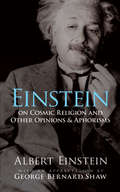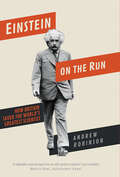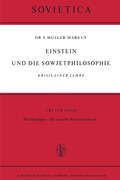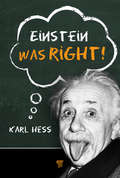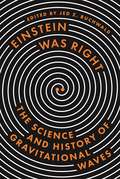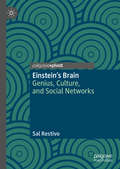- Table View
- List View
Einstein on Cosmic Religion and Other Opinions and Aphorisms
by George Bernard Shaw Albert EinsteinScience and religion are compatible, declares the famous physicist. In these essays, Einstein views science as the basis for a "cosmic" religion, embraced by scientists, theologians, and all who share a sense of wonder in the rationality and beauty of the universe. In the course of his career, Einstein wrote more than 300 scientific and 150 nonscientific publications. These essays date from the 1930s and 40s. In direct, everyday language the author develops a coherent view that transcends both the antiquated religion of fear and the modern religion of ethics. His concept of cosmic religion combines science and religion, with science forming the basis for a more enlightened religion. In these essays and aphorisms, Einstein also reflects on pacifism, disarmament, and Zionism. In addition to a brief biography of the author, this volume includes a warm appreciation by George Bernard Shaw.
Einstein on Einstein: Autobiographical and Scientific Reflections
by Jürgen Renn Hanoch GutfreundNew perspectives on the iconic physicist's scientific and philosophical formationAt the end of World War II, Albert Einstein was invited to write his intellectual autobiography for the Library of Living Philosophers. The resulting book was his uniquely personal Autobiographical Notes, a classic work in the history of science that explains the development of his ideas with unmatched warmth and clarity. Hanoch Gutfreund and Jürgen Renn introduce Einstein's scientific reflections to today's readers, tracing his intellectual formation from childhood to old age and offering a compelling portrait of the making of a philosopher-scientist.Einstein on Einstein features the full English text of Autobiographical Notes along with incisive essays that place Einstein's reflections in the context of the different stages of his scientific life. Gutfreund and Renn draw on Einstein's writings, personal correspondence, and critical writings by Einstein's contemporaries to provide new perspectives on his greatest discoveries. Also included are Einstein's responses to his critics, which shed additional light on his scientific and philosophical worldview. Gutfreund and Renn quote extensively from Einstein's initial, unpublished attempts to formulate his response, and also look at another brief autobiographical text by Einstein, written a few weeks before his death, which is published here for the first time in English.Complete with evocative drawings by artist Laurent Taudin, Einstein on Einstein illuminates the iconic physicist's journey to general relativity while situating his revolutionary ideas alongside other astonishing scientific breakthroughs of the twentieth century.
Einstein on Einstein: Autobiographical and Scientific Reflections
by Jürgen Renn Hanoch GutfreundNew perspectives on the iconic physicist's scientific and philosophical formationAt the end of World War II, Albert Einstein was invited to write his intellectual autobiography for the Library of Living Philosophers. The resulting book was his uniquely personal Autobiographical Notes, a classic work in the history of science that explains the development of his ideas with unmatched warmth and clarity. Hanoch Gutfreund and Jürgen Renn introduce Einstein's scientific reflections to today's readers, tracing his intellectual formation from childhood to old age and offering a compelling portrait of the making of a philosopher-scientist.Einstein on Einstein features the full English text of Autobiographical Notes along with incisive essays that place Einstein's reflections in the context of the different stages of his scientific life. Gutfreund and Renn draw on Einstein's writings, personal correspondence, and critical writings by Einstein's contemporaries to provide new perspectives on his greatest discoveries. Also included are Einstein's responses to his critics, which shed additional light on his scientific and philosophical worldview. Gutfreund and Renn quote extensively from Einstein's initial, unpublished attempts to formulate his response, and also look at another brief autobiographical text by Einstein, written a few weeks before his death, which is published here for the first time in English.Complete with evocative drawings by artist Laurent Taudin, Einstein on Einstein illuminates the iconic physicist's journey to general relativity while situating his revolutionary ideas alongside other astonishing scientific breakthroughs of the twentieth century.
Einstein on Politics: His Private Thoughts and Public Stands on Nationalism, Zionism, War, Peace, and the Bomb
by Albert Einstein David E. Rowe Robert SchulmannThe most famous scientist of the twentieth century, Albert Einstein was also one of the century's most outspoken political activists. Deeply engaged with the events of his tumultuous times, from the two world wars and the Holocaust, to the atomic bomb and the Cold War, to the effort to establish a Jewish homeland, Einstein was a remarkably prolific political writer, someone who took courageous and often unpopular stands against nationalism, militarism, anti-Semitism, racism, and McCarthyism. In Einstein on Politics, leading Einstein scholars David Rowe and Robert Schulmann gather Einstein's most important public and private political writings and put them into historical context. The book reveals a little-known Einstein--not the ineffectual and naïve idealist of popular imagination, but a principled, shrewd pragmatist whose stands on political issues reflected the depth of his humanity.Nothing encapsulates Einstein's profound involvement in twentieth-century politics like the atomic bomb. Here we read the former militant pacifist's 1939 letter to President Franklin D. Roosevelt warning that Germany might try to develop an atomic bomb. But the book also documents how Einstein tried to explain this action to Japanese pacifists after the United States used atomic weapons to destroy Hiroshima and Nagasaki, events that spurred Einstein to call for international control of nuclear technology.A vivid firsthand view of how one of the twentieth century's greatest minds responded to the greatest political challenges of his day, Einstein on Politics will forever change our picture of Einstein's public activism and private motivations.
Einstein on Politics: His Private Thoughts and Public Stands on Nationalism, Zionism, War, Peace, and the Bomb
by Albert Einstein David E. Rowe Robert SchulmannThe most famous scientist of the twentieth century, Albert Einstein was also one of the century's most outspoken political activists. Deeply engaged with the events of his tumultuous times, from the two world wars and the Holocaust, to the atomic bomb and the Cold War, to the effort to establish a Jewish homeland, Einstein was a remarkably prolific political writer, someone who took courageous and often unpopular stands against nationalism, militarism, anti-Semitism, racism, and McCarthyism. In Einstein on Politics, leading Einstein scholars David Rowe and Robert Schulmann gather Einstein's most important public and private political writings and put them into historical context. The book reveals a little-known Einstein--not the ineffectual and naïve idealist of popular imagination, but a principled, shrewd pragmatist whose stands on political issues reflected the depth of his humanity.Nothing encapsulates Einstein's profound involvement in twentieth-century politics like the atomic bomb. Here we read the former militant pacifist's 1939 letter to President Franklin D. Roosevelt warning that Germany might try to develop an atomic bomb. But the book also documents how Einstein tried to explain this action to Japanese pacifists after the United States used atomic weapons to destroy Hiroshima and Nagasaki, events that spurred Einstein to call for international control of nuclear technology.A vivid firsthand view of how one of the twentieth century's greatest minds responded to the greatest political challenges of his day, Einstein on Politics will forever change our picture of Einstein's public activism and private motivations.
Einstein on the Run: How Britain Saved the World's Greatest Scientist
by Andrew RobinsonThe first account of the role Britain played in Einstein's life—first by inspiring his teenage passion for physics, then by providing refuge from the Nazis In autumn 1933, Albert Einstein found himself living alone in an isolated holiday hut in rural England. There, he toiled peacefully at mathematics while occasionally stepping out for walks or to play his violin. But how had Einstein come to abandon his Berlin home and go ‘"on the run"? In this lively account, Andrew Robinson tells the story of the world’s greatest scientist and Britain for the first time, showing why Britain was the perfect refuge for Einstein from rumored assassination by Nazi agents. Young Einstein’s passion for British physics, epitomized by Newton, had sparked his scientific development around 1900. British astronomers had confirmed his general theory of relativity, making him internationally famous in 1919. Welcomed by the British people, who helped him campaign against Nazi anti-Semitism, he even intended to become a British citizen. So why did Einstein then leave Britain, never to return to Europe?
Einstein, Picasso: Space, Time, and the Beauty That Causes Havoc
by Arthur I MillerThe most important scientist of the twentieth century and the most important artist had their periods of greatest creativity almost simultaneously and in remarkably similar circumstances. This fascinating parallel biography of Albert Einstein and Pablo Picasso as young men examines their greatest creations -- Picasso's Les Demoiselles d'Avignon and Einstein's special theory of relativity. Miller shows how these breakthroughs arose not only from within their respective fields but from larger currents in the intellectual culture of the times. Ultimately, Miller shows how Einstein and Picasso, in a deep and important sense, were both working on the same problem.
Einstein, Picasso: Space, Time, and the Beauty That Causes Havoc
by Arthur J. MillerThe most important scientist of the twentieth century and the most important artist had their periods of greatest creativity almost simultaneously and in remarkably similar circumstances. This fascinating parallel biography of Albert Einstein and Pablo Picasso as young men examines their greatest creations-Picasso's Les Demoiselles d'Avignon and Einstein's special theory of relativity. Miller shows how these breakthroughs arose not only from within their respective fields but from larger currents in the intellectual culture of the times. Ultimately, Miller shows how Einstein and Picasso, in a deep and important sense, were both working on the same problem.
The Einstein, Podolsky, and Rosen Paradox in Atomic, Nuclear, and Particle Physics
by Alexander Afriat F. Selleri"Paradox" conjures up arrows and tortoises. But it has a speculative, gedanken ring: no one would dream of really conjuring up Achilles to confirm that he catches the tortoise. The paradox of Einstein, Podolsky, and Rosen, however, is capable of empirical test. Attempted experimental resolutions have involved photons, but these are not detected often enough to settle the matter. Kaons are easier to detect and will soon be used to discriminate between quantum mechanics and local realism. The existence ofan objective physical reality,which had disappeared behind the impressive formalism of quantum mechanics, was originally intended to be the central issue of the paradox; locality, like the mathematics used, was just assumed to hold. Quantum mechanics, with its incompatible measurements, was born rather by chance in an atmosphere of great positivistic zeal, in which only the obviously measurable had scientific respectability. Speculation about occult "unobservable" quantities was viewed as vacuous metaphysics, which should surely form no part of a mature scientific attitude. Soon the "unmeasurable, " once only disreputable, vanished altogether. One had first been told not to worry about it; then, as dogma got more carefully defined, one was assured that the unobserved was just not there. This made it easier not to think about it and to avoid hazardous metaphysical temptation.
Einstein Relation in Compound Semiconductors and Their Nanostructures (Springer Series in Materials Science #116)
by Kamakhya Prasad Ghatak Sitangshu Bhattacharya Debashis DeEinstein, Tagore and the Nature of Reality: Literary And Philosophical Reflections (Routledge Studies in the Philosophy of Mathematics and Physics)
by Partha GhoseThe nature of reality has been a long-debated issue among scientists and philosophers. In 1930, Rabindranath Tagore and Albert Einstein had a long conversation on the nature of reality. This conversation has been widely quoted and discussed by scientists, philosophers and scholars from the literary world. The important question that Tagore and Einstein discussed was whether the world is a unity dependent on humanity, or the world is a reality independent on the human factor. Einstein took the stand adopted by Western philosophers and mathematicians, namely that reality is something independent of the mind and the human factor. Tagore, on the other hand, adopted the opposite view. Nevertheless, both Einstein and Tagore claimed to be realists despite the fundamental differences between their conceptions of reality. Where does the difference lie? Can it be harmonized at some deeper level? Can Wittgenstein, for example, be a bridge between the two views? This collection of essays explores these two fundamentally different conceptions of the nature of reality from the perspectives of theories of space-time, quantum theory, general philosophy of science, cognitive science and mathematics.
Einstein, Tagore and the Nature of Reality: Literary And Philosophical Reflections (Routledge Studies in the Philosophy of Mathematics and Physics)
by Partha GhoseThe nature of reality has been a long-debated issue among scientists and philosophers. In 1930, Rabindranath Tagore and Albert Einstein had a long conversation on the nature of reality. This conversation has been widely quoted and discussed by scientists, philosophers and scholars from the literary world. The important question that Tagore and Einstein discussed was whether the world is a unity dependent on humanity, or the world is a reality independent on the human factor. Einstein took the stand adopted by Western philosophers and mathematicians, namely that reality is something independent of the mind and the human factor. Tagore, on the other hand, adopted the opposite view. Nevertheless, both Einstein and Tagore claimed to be realists despite the fundamental differences between their conceptions of reality. Where does the difference lie? Can it be harmonized at some deeper level? Can Wittgenstein, for example, be a bridge between the two views? This collection of essays explores these two fundamentally different conceptions of the nature of reality from the perspectives of theories of space-time, quantum theory, general philosophy of science, cognitive science and mathematics.
Einstein und die Sowjetphilosophie: Krisis Einer Lehre Zweiter Band Die allgemeine Relativitätstheorie (Sovietica #22)
by S. Müller-MarkusEinstein und Die Sowjetphilosophie: Krisis einer Lehre (Sovietica #5)
by S. Müller-MarkusDieses Buch soll ein Bericht über den Prozess Einstein sein. Es enthält das Material über die Diskussion um die Relativitätstheorie in der UdSSR seit 1950. Von 1951 bis 1955 wurde Einstein durch die offizielle Parteiphilosophie der UdSSR in den Anklagezustand versetzt. Der Prozess gipfelte in der Aufforderung, die Relativitätstheorie zu verwerfen und durch eine materialistische 'Theorie schneller Bewegungen' zu ersetzen. Selbst der Name 'Relativitätstheorie' sollte aus den physikalischen Lehrbüchern verschwinden. Die Anklage wurde vertreten von der ideologischen Führungsschicht der gewaltigsten irdischen Macht unseres Zeitalters. Der Angeklagte, in der Reife seines Lebens vor die vehementesten Angriffe gestellt, kam nur durch sein Werk zu Wort. Dies genügte jedoch, dass sich unter den sowjetischen Physikern und Philosophen noch zur Zeit Stalins mannhafte Stimmen der Verteidigung fanden. 1955 wurde der Prozess mit der offiziellen Anerkennung der Relativitäts theorie durch die Parteiphilosophie abgeschlossen. Es war ein Sieg der Wahrheit über die Gewalt. Die Folgen mussten das Ansehen der kommunistischen Ideologie erschüttern. Es hatte sich herausgestellt, dass zwischen der angeblich einzig wissenschaftlichen Philosophie und der exaktesten Naturwissen schaft, der Physik, ein Abgrund klafft, den zu überbrücken die Sowjet philosophie bis heute bemüht ist. Andererseits begannen die sowjetischen Physiker, wachgerufen durch die Appelle der Philosophen, ihr eigenes Weltbild mit adäquaten Methoden zu durchdenken. Diese ganze Ent wicklung ist von hohem Wert für eine Diagnose der geistigen Struktur der Sowjetgesellschaft.
Einstein Was Right!
by Karl HessAll modern books on Einstein emphasize the genius of his relativity theory and the corresponding corrections and extensions of the ancient space-time concept. However, Einstein's opposition to the use of probability in the laws of nature and particularly in the laws of quantum mechanics is criticized and often portrayed as outdated. The author of E
Einstein Was Right: The Science and History of Gravitational Waves
by Kip S. Thorne Harry Collins Jürgen Renn Daniel Kennefick Tilman Sauer Don Howard Alessandra Buonanno Professor Diana K. Buchwald Barry C. BarishAn authoritative interdisciplinary account of the historic discovery of gravitational wavesIn 1915, Albert Einstein predicted the existence of gravitational waves—ripples in the fabric of spacetime caused by the movement of large masses—as part of the theory of general relativity. A century later, researchers with the Laser Interferometer Gravitational-Wave Observatory (LIGO) confirmed Einstein's prediction, detecting gravitational waves generated by the collision of two black holes. Shedding new light on the hundred-year history of this momentous achievement, Einstein Was Right brings together essays by two of the physicists who won the Nobel Prize for their instrumental roles in the discovery, along with contributions by leading scholars who offer unparalleled insights into one of the most significant scientific breakthroughs of our time.This illuminating book features an introduction by Tilman Sauer and invaluable firsthand perspectives on the history and significance of the LIGO consortium by physicists Barry Barish and Kip Thorne. Theoretical physicist Alessandra Buonanno discusses the new possibilities opened by gravitational wave astronomy, and sociologist of science Harry Collins and historians of science Diana Kormos Buchwald, Daniel Kennefick, and Jürgen Renn provide further insights into the history of relativity and LIGO. The book closes with a reflection by philosopher Don Howard on the significance of Einstein's theory for the philosophy of science.Edited by Jed Buchwald, Einstein Was Right is a compelling and thought-provoking account of one of the most thrilling scientific discoveries of the modern age.
The Einsteinian Revolution: The Historical Roots of His Breakthroughs
by Jürgen Renn Hanoch GutfreundHow the Einsteinian revolution can be understood as the result of a long-term evolution of science The revolution that emerged from Albert Einstein’s work in the early twentieth century transformed our understanding of space, time, motion, gravity, matter, and radiation. Beginning with Einstein’s miracle year of 1905 and continuing through his development of the theory of general relativity, Einstein spurred a revolution that continues to reverberate in modern-day physics. In The Einsteinian Revolution, Hanoch Gutfreund and Jürgen Renn trace the century-long transformation of classical physics and argue that the revolution begun by Einstein was in fact the result of a long-term evolution. Describing the origins and context of Einstein’s innovative research, Gutfreund and Renn work to dispel the popular myth of Einstein as a lone genius who brought about a revolution in physics through the power of his own pure thought. We can only understand the birth of modern physics, they say, if we understand the long history of the evolution of knowledge.Gutfreund and Renn outline the essential structures of the knowledge system of classical physics on which Einstein drew. Examining Einstein’s discoveries from 1905 onward, they describe the process by which new concepts arose and the basis of modern physics emerged. These transformations continued, eventually resulting in the establishment of quantum physics and general relativity as the two major conceptual frameworks of modern physics—and its two unreconciled theoretical approaches. Gutfreund and Renn note that Einstein was dissatisfied with this conceptual dichotomy and began a search for a unified understanding of physics—a quest that continued for the rest of his life.
The Einsteinian Revolution: The Historical Roots of His Breakthroughs
by Jürgen Renn Hanoch GutfreundHow the Einsteinian revolution can be understood as the result of a long-term evolution of science The revolution that emerged from Albert Einstein’s work in the early twentieth century transformed our understanding of space, time, motion, gravity, matter, and radiation. Beginning with Einstein’s miracle year of 1905 and continuing through his development of the theory of general relativity, Einstein spurred a revolution that continues to reverberate in modern-day physics. In The Einsteinian Revolution, Hanoch Gutfreund and Jürgen Renn trace the century-long transformation of classical physics and argue that the revolution begun by Einstein was in fact the result of a long-term evolution. Describing the origins and context of Einstein’s innovative research, Gutfreund and Renn work to dispel the popular myth of Einstein as a lone genius who brought about a revolution in physics through the power of his own pure thought. We can only understand the birth of modern physics, they say, if we understand the long history of the evolution of knowledge.Gutfreund and Renn outline the essential structures of the knowledge system of classical physics on which Einstein drew. Examining Einstein’s discoveries from 1905 onward, they describe the process by which new concepts arose and the basis of modern physics emerged. These transformations continued, eventually resulting in the establishment of quantum physics and general relativity as the two major conceptual frameworks of modern physics—and its two unreconciled theoretical approaches. Gutfreund and Renn note that Einstein was dissatisfied with this conceptual dichotomy and began a search for a unified understanding of physics—a quest that continued for the rest of his life.
Einsteins Akte: Wissenschaft und Politik - Einsteins Berliner Zeit
by Siegfried Grundmanno Erstmals veröffentlichte Zeitdokumente und bisher unbekannte Einstein-Dokumenteo Von einem Wissenschaftshistoriker sorgfältig analysiert und kommentierto Übersichtlich gestaltet und mit zahlreichen Fotos ausgestattet"Einsteins Akte" ist ein faszinierendes Dokument der deutschen Zeit- und Wissenschaftsgeschichte, das den Platz Einsteins in der Politik des Kaiserreichs, der Weimarer Republik und des Dritten Reichs beleuchtet.Das Buch basiert auf der Analyse verschiedener Akten über Einstein, überwiegend aber der Akte "Einsteins Relativitätstheorie", die so exakt, umfangreich und vielseitig wie keine andere die Komplexität der Vorgänge um Einstein erfaßt.Aus Primärquellen rekonstruiert der Autor das politische und gesellschaftliche Geschehen dieser Zeit, in dessen Verlauf Einstein gefördert, angefeindet und schließlich vertrieben wurde. Ein wichtiger Beitrag zum Verständnis für Einsteins Bruch mit Deutschland.
Einsteins Akte: Einsteins Jahre in Deutschland aus der Sicht der deutschen Politik
by Siegfried Grundmanno Erstmals veröffentlichte Zeitdokumente und bisher unbekannte Einstein-Dokumenteo Von einem Wissenschaftshistoriker sorgfältig analysiert und kommentierto Übersichtlich gestaltet und mit zahlreichen Fotos ausgestattet"Einsteins Akte" ist ein faszinierendes Dokument der deutschen Zeit- und Wissenschaftsgeschichte, das den Platz Einsteins in der Politik des Kaiserreichs, der Weimarer Republik und des Dritten Reichs beleuchtet.Das Buch basiert auf der Analyse verschiedener Akten über Einstein, überwiegend aber der Akte "Einsteins Relativitätstheorie", die so exakt, umfangreich und vielseitig wie keine andere die Komplexität der Vorgänge um Einstein erfaßt.Aus Primärquellen rekonstruiert der Autor das politische und gesellschaftliche Geschehen dieser Zeit, in dessen Verlauf Einstein gefördert, angefeindet und schließlich vertrieben wurde. Ein wichtiger Beitrag zum Verständnis für Einsteins Bruch mit Deutschland.
Einsteins Berlin: Auf den Spuren eines Genies
by Dieter Hoffmann"At Easter I'm going to Berlin as an Academy man without any obligations, rather like a living mummy," Albert Einstein wrote in the fall of 1913. The most important physicist of the 20th century worked for nearly two decades in the Prussian metropolis. These twenty years represent the pinnacle of his scientific and social recognition -- however they were also a period of increasing political and anti-Semitic attacks. So what were the personal and scientific relationships that bonded Einstein so closely to Berlin? The author, himself an expert in scientific history, provides the answers: Readers accompany Einstein via 30 places in Berlin and surroundings, getting to know his contemporaries and all the important scenes of his life in the capital. Numerous illustrations and photos of the historic settings and details from today's street map allow readers to locate these places and so take a tour of one of the most significant chapters in modern history of science.
Einstein’s Brain: Genius, Culture, and Social Networks
by Sal RestivoThis book reviews the research on Einstein’s brain from a sociological perspective and in the context of the social brain paradigm. Instead of “Einstein, the genius of geniuses” standing on the shoulders of giants, Restivo proposes a concept of Einstein the social being standing on the shoulders of social networks. Rather than challenging Einstein’s uniqueness or the uniqueness of his achievements, the book grounds Einstein and his achievements in a social ecology opposed to the myths of the “I,” individualism, and the very idea of “genius.” “Einstein” is defined by the particular configuration of social networks that he engaged as his life unfolded, not by biological inheritances.
Einstein's Cosmos: How Albert Einstein's Vision Transformed Our Understanding of Space and Time (Great Discoveries Ser. #0)
by Michio KakuFew figures loom as large as Albert Einstein in our contemporary culture. It is truly remarkable that a man from such humble beginnings, an unemployed dreamer without a future or a job, who was written off by his professors as a hopeless loser, could to dare to scale the heights he reached. In this enlightening book, Michio Kaku reasseses Einstein's work by centring on his three great theories: special relativity, general relativity and the Unified Field Theory. He first yielded the equation E =mc² which is now such a fixture in our culture that it is practically a ubiquitous slogan. But the subsequent theories led to the Big Bang theory, and have changed irrevocably the way we perceive time and space.Michio Kaku offers a new, refreshing look at the pioneering work of Einstein, giving a more accurate portrayal of his enduring legacy than previous biographies. As today's advanced physicists continue their search to fulfil Einstein's most cherished dream, a 'theory of everything', he is recognised as a prophet who set the agenda for modern physics.
Einstein's Dice and Schrödinger's Cat: How Two Great Minds Battled Quantum Randomness to Create a Unified Theory of Physics
by Paul Halpern"A fascinating and thought-provoking story, one that sheds light on the origins of... the current challenging situation in physics."--Wall Street JournalWhen the fuzzy indeterminacy of quantum mechanics overthrew the orderly world of Isaac Newton, Albert Einstein and Erwin Schrödinger were at the forefront of the revolution. Neither man was ever satisfied with the standard interpretation of quantum mechanics, however, and both rebelled against what they considered the most preposterous aspect of quantum mechanics: its randomness. Einstein famously quipped that God does not play dice with the universe, and Schrödinger constructed his famous fable of a cat that was neither alive nor dead not to explain quantum mechanics but to highlight the apparent absurdity of a theory gone wrong. But these two giants did more than just criticize: they fought back, seeking a Theory of Everything that would make the universe seem sensible again.In Einstein's Dice and Schrödinger's Cat, physicist Paul Halpern tells the little-known story of how Einstein and Schrödinger searched, first as collaborators and then as competitors, for a theory that transcended quantum weirdness. This story of their quest-which ultimately failed-provides readers with new insights into the history of physics and the lives and work of two scientists whose obsessions drove its progress.Today, much of modern physics remains focused on the search for a Theory of Everything. As Halpern explains, the recent discovery of the Higgs Boson makes the Standard Model-the closest thing we have to a unified theory- nearly complete. And while Einstein and Schrödinger failed in their attempt to explain everything in the cosmos through pure geometry, the development of string theory has, in its own quantum way, brought this idea back into vogue. As in so many things, even when they were wrong, Einstein and Schrödinger couldn't help but get a great deal right.
Einstein’s Dream: The Search for a Unified Theory of the Universe
by Barry R. ParkerThirty years ago Albert Einstein died, his dream of a theory that would unify the universe unfulfilled. He spent the last decades of his life searching for such a theory-a theory that would explain everything from elementary particles and their interac tions to the overall structure of the universe. But he failed, not because he didn't try hard enough, but because the attempt was ahead of its time. When Einstein worked on the problem liter ally nothing was known about black holes, white holes, sin gularities, the Big Bang explosion and the early universe, quarks, gauge invariance, and weak and strong nuclear forces. Today we know that all these things are important in relation to a unified theory, and that they must be incorporated in and explained by such a theory. Thus, in a sense, our problem is much more complex today than it was in Einstein's day. But scientists have persevered and as a result we are now tan talizingly close to achieving this long-sought goal. Important breakthroughs have been made. In this book we will look at these breakthroughs and at recent unified theories-theories that go by the names supergravity, superstrings, GUTs, and twistor theory. In order to understand the problem, however, we must begin at the beginning.
